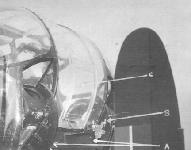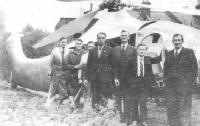Фотографии
-
Регистрационный номер: XZ357 At first sight just another grey-painted RAF Jaguar, but XZ357 does have some measure of uniqueness in that it is the first aircraft of its type in a new, permanent darker shade of grey. This will replace the temporary finish used on Jaguars deployed on the Deny Flight operation and being polyurethane, should wear better in service. 'Foxtrot Kilo' was flown on this photo-sortie by Wg Cdr Tim Kerrs, OC No 54 Sqn, accompanied by the T.2 camera ship XX841 flown by Flt Lt John Sullivan, both based at RAF Coltishall. Contrasting with the wintry sea and sky of a February day, are the 'White Cliffs' near Dover.
Самолёты на фотографии: SEPECAT Jaguar - International - 1969
-
Самолёты на фотографии: SEPECAT Jaguar - International - 1969
-
Самолёты на фотографии: SEPECAT Jaguar - International - 1969
-
Afterburners glowing, a No 617 ‘Dambusters’ Sqn Tornado GR.1B powers across the bleak coast of the Orkney islands on a practise mission from RAF Lossiemouth. Under the fuselage, two Sea Eagle anti-ship missiles.
Самолёты на фотографии: Panavia Tornado IDS (GR) - International - 1974
-
Регистрационный номер: ZG711 Tornado GR.1a of No 13 Sqn at RAF Marham in markings to celebrate the squadron’s 80th anniversary which is to be held on July 8, 1995.
Самолёты на фотографии: Panavia Tornado IDS (GR) - International - 1974
-
Регистрационный номер: WE275 The UK’s population of airworthy DH.112 Venoms has been further increased by Don Wood’s Source Classic Jet Flight at Hurn. Although this latest addition was acquired in 1984 along with the other airworthy Source Venom, G-VENI, it has only been in the last year that it has received the attentions of Don Wood’s engineers, John Chillingworth and Bernie Smith, to put it back in the air.
Самолёты на фотографии: De Havilland Venom / D.H.112 - Великобритания - 1949
-
Регистрационный номер: OE-LRD Lauda Air recently inaugurated a new service between London Gatwick and Salzburg using Canadair RJ OE-LRD.
Самолёты на фотографии: Bombardier CRJ100 / CRJ200 / CRJ800 - Канада - 1991
-
Регистрационный номер: СССР-85727 Typical of the subjects seen during the Estonian tour in 1993 was this Tu-154.
Самолёты на фотографии: Туполев Ту-154 - Россия - 1968
-
Самолёты на фотографии: Avro Lancaster / Type 683 - Великобритания - 1941
-
Регистрационный номер: ME381 FN121 turret of Lancaster III ME381 fitted for self-towing drogues showing, at centre, the quick release mechanism.
Самолёты на фотографии: Avro Lancaster / Type 683 - Великобритания - 1941
-
Регистрационный номер: LM296 RB No 2 Mk 1 turret of Lancaster B.1 LM296 with drogue shown folded.
Самолёты на фотографии: Avro Lancaster / Type 683 - Великобритания - 1941
-
The rogue Constellation, photographed by Patrick Cummins during the 1970s.
Самолёты на фотографии: Lockheed Constellation C-69 / C-121 - США - 1943
-
Регистрационный номер: G-MAJB All three airliners built at Prestwick by British Aerospace Jetstream Aircraft are now flying in British Airways colours. The latest is the Jetstream 41 of Manx Airlines now operating BA Express services.
Самолёты на фотографии: Handley Page/BAe Jetstream / H.P.137 - Великобритания - 1967
-
Регистрационный номер: HC-AVP, I-LARK HC-AVP of Sociedad Anonima Ecuatoriana de Transportes Aeros (SAETA), an ex-Alitalia Viscount 785 (I-LARK), parked in front of the control tower at Mariscal Sucre Airport in August 1974.
Самолёты на фотографии: Vickers Viscount - Великобритания - 1948
-
Регистрационный номер: HC-ASP HC-ASP, a Viscount 828 of Servicios Aereos Nacionales (SAN), at Mariscal Sucre Airport in 1974.
Самолёты на фотографии: Vickers Viscount - Великобритания - 1948
-
Регистрационный номер: N7428 N7428, a Viscount 700 leased from Texas-based Airworld by Servicios Aereos Nacionales (SAN).
Самолёты на фотографии: Vickers Viscount - Великобритания - 1948
-
Регистрационный номер: XX190 RAF Valley BAe Hawk T.1s have now received their unit badges. Seen here, top to bottom, are aircraft of No 208(R), 19(R) and 74(R) Squadrons.
Самолёты на фотографии: Hawker-Siddeley Hawk / HS.1182 - Великобритания - 1972
-
Регистрационный номер: SE-ADU The Cierva C.19 Mk IV SE-ADU on the deck of the Lise after it had been recovered from the Baltic, together with its pilot, in September 1940.
Самолёты на фотографии: Cierva/Avro C.19 - Великобритания - 1929
-
Регистрационный номер: RE240 BP Type ‘D’ turret of Lincoln B.I RE240 showing: A, drogue towing bracket; B, quick release hook; C, turret window through which the folded drogues were released for streaming. Up to six drogues were carried for each trials flight by Lancasters and the Lincoln.
Самолёты на фотографии: Avro Lincoln / Type 694 - Великобритания - 1944
-
Регистрационный номер: PX203 [2] The Cierva W.9 as tested by Alan Marsh, who was CO of No 529 Sqn, RAF, flying Cierva C.30As and Avro Rotas at Henley-on-Thames until its disbandment in October 1945.
Самолёты на фотографии: Cierva W.9 - Великобритания - 1944
-
Регистрационный номер: PX203 [2] The Cierva W.9 at Thames Ditton in 1944. The members of the development and construction team posing in front of the protoype are not identified, but presumably include C G Pullin, J S Shapiro, Ken Watson and perhaps Ray Pullin.
Самолёты на фотографии: Cierva W.9 - Великобритания - 1944
Статьи
- -
- Airshow'95
- Register Review
- ??? - Military aircraft markings (2)
- A.Boxman, K.van der Mark - Aeronavale: France's naval air arm today (1)
- A.Jackson - Comet I - Success and Disaster
- G.Swanborough - British aircraft at war, 1939-1945 (16)
- J.Green - Air Zimbabwe /Airline Profile/
- M.Fielding - The Jet Defectors
- R.Jackson - Airport Movements




















